Daily News
by Gail Helmer
[ Send Us News | Archives ]
U.S. Reaches Settlement with Microsoft
WASHINGTON (Reuters) - The U.S. Justice Department reached an antitrust settlement with Microsoft that would give computer makers freedom to feature other software and require Microsoft to share the inner workings of its Windows computer operating system with other software makers, the government said on Friday. The pact, which must be endorsed by a federal judge and the 18 states in the case, is a far cry from splitting the company in two, a remedy sought by the previous administration of President Bill Clinton. But even some of the more skeptical state attorneys general saw merit in the settlement and expressed optimism that they could endorse it next week. [More...]
OpFlash Unofficial Winter Add-on
An Unofficial Winter add-on is now available for Operation Flashpoint. It adds a new island, named Winter Kolgujev. Download
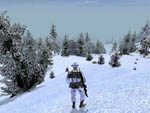
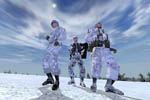

OpFlash Beta Server V1.29 Available
Operation Flashpoint dedicated Server Beta version 1.29 is available now. Download
OpFlash Weapons Pack 1 Released
New official addon "Weapons Pack 1".for Operation Flashpoint is now available. New weapons include, Bizon, G36A, Steyr Aug, and the XM-S. Download
Medal Of Honor: Allied Assault Update
We have a quick update on Medal of Honor: Allied Assault. COMBATSIM has learned that a multiplayer demo is expected mid to late December. We will keep you posted.
Military News
US Navy Drops DD21 Announces New Programme
The Navy announced today that it will issue a revised Request for Proposal (RFP) for the Future Surface Combatant Program. Formerly known as DD 21, the program will now be called "DD(X)" to more accurately reflect the program purpose, which is to produce a family of advanced technology surface combatants, not a single ship class.
Deputy Secretary of Defense Paul Wolfowitz approved the revised program focus and reaffirmed the Department's support for the Future Surface Combatant Program.
"President Bush has made transformation of the Department of Defense a high priority. Through DD(X), the Navy has charted a course to transformation that will provide capability across the full spectrum of naval warfare. The Navy's strategy supports assured access to littoral regions and also develops the capability to defeat the air and missile defense threats the nation's naval forces will face in the future."
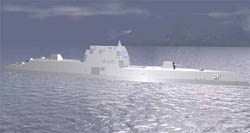
DD21 Concept
Under Secretary of Defense for Acquisition, Technology and Logistics E. C. "Pete" Aldridge stated that "the new program focus and new RFP will enable the Navy to fully leverage the great work already done by the two industry teams, continue risk mitigation measures and permit appropriate spiral development of technology and engineering to support a range of future surface ships to meet our Nation's maritime requirements well into the 21st Century," Aldridge said. "The DD(X) program will be the technology driver for the surface fleet of the future."
"With the approval of this strategy, the Navy has defined its surface combatant roadmap for the future in a manner which ensures all maritime missions can be accomplished. Through DD(X), we are taking a significant step toward providing improved combat capability for our Sailors and Marines," said Navy Secretary Gordon England.
Chief of Naval Operations Adm. Vern Clark said the DD(X) program reflects an awareness that effectively defeating future threats, while accomplishing naval missions, will require a range of naval capabilities and different surface platforms.
"One size fits all will not work on the future battlefield," Clark said. "We must continue to exploit the robust R&D effort made on DD 21 even as we focus our research and technology funding of other approaches such as the Littoral Combat Ship concept."
The DD(X) program will provide a baseline for spiral development of the DD(X) and the future cruiser or "CG(X)" with emphasis on common hullform and technology development. The Navy will use the advanced technology and networking capabilities from DD(X) and CG(X) in the development of the Littoral Combat Ship with the objective being a survivable, capable near-land platform to deal with threats of the 21st century. The intent is to innovatively combine the transformational technologies developed in the DD(X) program with the many ongoing R&D efforts involving mission focused surface ships to produce a state-of-the art surface combatant to defeat adversary attempts to deny access for US forces.
The revision of the program is based on the Navy's continued careful examination of DD21 as it reached the source selection milestone this past spring. At that time, the Navy delayed the down-select decision between the two competing DD21 teams in order to take advantage of ongoing reviews being conducted in the Department of Defense, including the Quadrennial Defense Review. The Navy expects to issue the revised RFP within the next few weeks, and to down-select a single industry team to be the design agent and technology developer this Spring.
Lockheed Martin Delivers First TB29A Towed Array
Lockheed Martin today announced the delivery of its first TB-29A thin-line towed array to the US Navy for testing under a $6.4 million development/production contract awarded in April 2000. Towed arrays are sensors attached by tow cables to surface ships and submarines, enabling them to detect acoustic energy. Lockheed Martin Naval Electronics and Surveillance Systems (NE&SS) in Syracuse is the prime contractor for the TB-29A program. Under the current development/production contract, it will build 10 more TB-29A towed arrays along with its major subcontractor, L-3 Communications. Lockheed Martin received a $31.7 million order for engineering and manufacturing services for the upgraded sonar in December 1998. The TB-29A costs half as much as its TB-29 predecessor, with the same level of performance.
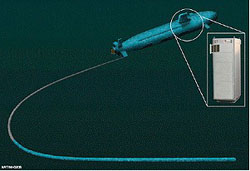
"We're able to reduce the cost of the towed array sonar by using commercial off-the-shelf (COTS) technology adapted from the telecommunications industry," said Scott Gring, TB-29A programme manager. The first TB-29A initially will be towed by a Los Angeles-class submarine but it also will be towed by Seawolf and Virginia-class submarines.
"We produced the first towed array for the Navy 40 years ago and continue to be the world leader in this technology," said Frank DeBritz, president, NE&SS-Undersea Systems. "We have made a significant capital investment in array manufacturing, testing and repair facilities, which will enable us to leverage further array technology enhancements."
Rumsfeld: Don't Expect 'Instant Victory' In Anti-Terror War
Defense Secretary Donald H. Rumsfeld today figuratively flung down the gauntlet in response to recent media reports suggesting the Afghan military campaign is bogged down or somehow floundering.
The air campaign, started Oct. 7 to root out Osama bin Laden, the Al Qaeda network of terrorists and Taliban supporters from Afghanistan, is just over three weeks old, Rumsfeld told reporters at the Pentagon. AFRTS Radio Reports:
"SecDef plans to increase the number of troops on the ground in Afghanistan"
"SecDef says Americans know the truth about the war on terrorism"
The ruins of the New York World Trade Center "are still smoking," he emphasized, adding that defeating terrorists in Afghanistan and the broader war against global terrorism are tasks "that will take time to accomplish."
Rumsfeld said he had outlined several goals at the Oct. 7 start of the air campaign in Afghanistan:
Yesterday's air operations in Afghanistan "focused on destroying command-and-control elements, whether in bunkers, tunnels, or caves," said Air Force Gen. Richard B. Myers, chairman of the Joint Chiefs of Staff, accompanying the defense secretary at the press conference.
American air operations also concentrated on reducing Taliban military ground forces in Afghanistan, Myers added. He said eight planned target areas were hit around the Afghan cities of Mazar-e Sharif, Kabul, Kandahar and other "engagement zones" within the country.
About 55 strike aircraft were used in the attacks, he said, including approximately 40 carrier-based jets, between 4-6 land-based tactical aircraft and about 8-10 long-range bombers.
Myers said two C-17 aircraft yesterday delivered about 34,000 food rations to needy persons in northern Afghanistan for a total of about 1,062,000 rations delivered since Oct. 7.
Commando Solo radio broadcasts and leaflet missions were conducted near Mazar-e Sharif, Myers noted.
Myers showed combat imagery depicting F-14 and F-18 aircraft successfully attacking a cave complex near the Afghan capital city of Kabul. He said Al Qaeda and the Taliban used the caves as secure locations for personnel, and to store ammunition and equipment.
America's fight against terrorism "is much broader, than in simply defeating Taliban or Al Qaeda" in Afghanistan, Rumsfeld noted.
"It is to root out the global terrorist networks, not just in Afghanistan, but wherever they are, to ensure that they cannot threaten the American people or our way of life," he emphasized.
America and its allies are now "fighting a new kind of war," Rumsfeld noted, that is in many ways different from other conflicts from the past.
"But, as I have said, one of those differences is not the possibility of instant victory or instant success." He expressed confidence that victory over the forces of global terrorism is inevitable, noting the battle will require that "every element of American influence and power be engaged."
Americans, he emphasized, "have seen tougher adversaries than this before, and they've had the staying power to defeat them."
Underestimating the strength and resolve of the American people "is a big mistake," Rumsfeld said, adding, "In the end, war is not about statistics, deadlines, short attention spans, or 24-hour news cycles.
Winning the war against global terrorism "is about will, the projection of will," said Rumsfeld.
"The clear, unambiguous determination of the President of the United States … and the American people is to see this through to certain victory," he said.
Fighters, Bombers not Only Planes Flying in Afghanistan
It takes more than just fighters and bombers to wage a successful air war, a senior DoD official said.
Rear Adm. John Stufflebeem told Pentagon press Oct. 31 that military pilots make many flights besides bombing runs in support of Operation Enduring Freedom. Stufflebeem is the Joint Staff's deputy director of operations for current readiness and capabilities.
"We have other aircraft that fly intelligence missions as well as tankers and support aircraft," Stufflebeem said. He said he doesn't have specific numbers of support flights, but that his background as an F-14 pilot tells him numerous tankers are needed to refuel the planes that actually drop the bombs.
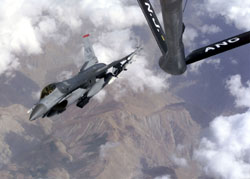
"These are long missions. I have seen reports that some aircrews are flying missions in durations of 10-to 13 hours," Stufflebeem said. "Any aircraft that's going to spend that much time airborne either loitering or in distance travel is going to need fuel."
He estimated up to a dozen tankers are needed to support each day's bombing runs. The admiral said other types of aircraft support the operation in other ways as well, such as intelligence gatherers, Stufflebeem said.
He showed reporters several still and video images from recent operations. A set of photos showed before and after images of an Al Qaeda terrorist training camp near Kandahar that has been damaged in recent attacks. "Al Qaeda used to use this facility to train terrorists in small-unit combat operations," Stufflebeem said. "Much of the facility was damaged or destroyed over the course of the past couple weeks." Three video clips showed Taliban armored vehicles being destroyed by F-14 and F-18 strike aircraft over the past two days. One of the weapons system videos was taken near Mazar-e-Sharif, and the other two were from near Kandahar, Stufflebeem said.
Forces in the region reached a milestone in humanitarian support to the Afghan people Oct. 30. C-17 Globemaster III cargo aircraft dropped more than 34,000 humanitarian daily rations, bringing the total delivered to more than a million so far, he said.
Bomber Strikes From Diego Garcia A 15-Hour Ordeal
Bomber crews who fly strike missions over Afghanistan from Diego Garcia atoll have "quite a drive" to get to and from their targets.
Each round trip sortie, flown mostly over the vast Indian Ocean, may last from 12 to 15 hours, may involve extended stays over the country, and can be more than 5,500 miles.
Threats to aircrews are almost nonexistent, said "Lucky," a bomber pilot, during an Oct. 31 television interview from the British-controlled territory.
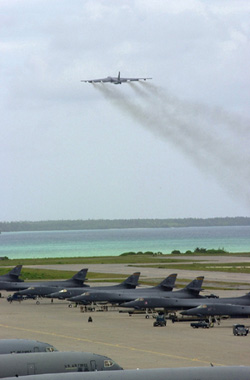
"The air defenses we’ve seen have been minimal," Lucky said. He is on duty with the 28th Air Expeditionary Wing on the 17-square-mile atoll of coral and sand in the middle of the Indian Ocean. We have "Not really seen any direct threat."
Lucky, who flew 12 missions during Operation Allied Force, said Afghan air defenses don’t compare to those he faced over Kosovo. Aircrews receive excellent air defense intelligence, he said. Even so, aircrews fly with heightened awareness of their surroundings.
"You’re definitely looking [for threats] the whole time you’re there," Lucky said.
Then there is the long flight home, said "Bama," a bomber weapons system officer. There is a bit of a letdown once the bombers are over the ocean and headed home, she said.
"You’re more relaxed, in a sense," Bama said. "But at the same time, our feet aren’t on the ground, and we still have a lot more flying to do."
Including mission planning, each strike is at least a 24-hour affair. Planning is done mostly at night and takes hours. Before a strike, aircrews study flight plans. Most people memorize the bomb run, Lucky said.
On the way to the target, aircrews spend a lot of time running through the potential problems or threats they may encounter.
Still, missions over Afghanistan are easier than those flown from home base at Ellsworth Air Force Base, S.D., Lucky said. The base is home to the 28th Bomb Wing.
Flying over Afghanistan is a lot like training runs over the Utah Test and Training Range, he said. But stateside, threats tossed into a mission are much more complicated and harder to defeat.
At Diego Garcia, the support team that keeps the bombers flying works nonstop. When the unit arrived, troops worked around the clock for three weeks to bed down their bombers. Nobody got a day off.
Twelve-hour shifts are still the norm. But troops are not complaining, said "Otis," a maintenance operations center controller.
"We’re extremely focused on the task at hand," he said.
Plus, everyone is anxious to help ensure the success of the war on terrorism, Otis said. That equates to ready-to-fly bombers.
The bombers have flown with few incident or breaks, said Col. Ed Rice, the deployed wing commander. Missions have "been greatly successful," he said.
These aircraft are just part of the success of Operation Enduring Freedom air strikes on Taliban and al Qaeda targets. Air Force aircraft have flown more than 1,800 sorties. They have dropped more than 76 percent of all bombs and damaged or destroyed three-quarters of their targets. More than two-thirds of the bombs were precision weapons. The strikes have hit early warning radar, ground forces, command-and-control facilities, airfields and aircraft.
Aircrews do everything possible to "ensure we hit the targets we intend to hit" and avoid causing collateral damage, Rice said. But he said he knows some bombs will go astray.
"I think we’ve done a pretty good job so far," he said.
The airmen at Diego Garcia are far from where the bombs land. They do not see the results, but they do have a hand in the success of Operation Enduring Freedom. That is why they do not mind the long hours, and they can deal with the family separation. That comes with the job, they said.
They maintain a strong sense of purpose in all they do, Lucky said.
For their efforts, the aircrews and maintainers said they ask for very little.
Otis said he just asks Americans to stand behind their military and remember what they are doing for their country.
It is key that people back home continue to take care of the families airmen left behind, because knowing their families are safe will let a lot of airmen rest easy at night, Rice said.
That, he said, "is extremely important to the end result of what we’re trying to achieve."
[ Send Us News | Archives ]
by Gail Helmer
Friday November 02, 2001
- U.S. Reaches Settlement with Microsoft
- OpFlash Unofficial Winter Add-on
- OpFlash Beta Server V1.29 Available
- OpFlash Weapons Pack 1 Released
- Medal Of Honor: Allied Assault Update
- US Navy Drops DD21 Announces New Programme
- Lockheed Martin Delivers First TB29A Towed Array
- Rumsfeld: Don't Expect 'Instant Victory' In Anti-Terror War
- Fighters, Bombers not Only Planes Flying in Afghanistan
- Bomber Strikes From Diego Garcia A 15-Hour Ordeal
- Jane's News Briefs
U.S. Reaches Settlement with Microsoft
WASHINGTON (Reuters) - The U.S. Justice Department reached an antitrust settlement with Microsoft that would give computer makers freedom to feature other software and require Microsoft to share the inner workings of its Windows computer operating system with other software makers, the government said on Friday. The pact, which must be endorsed by a federal judge and the 18 states in the case, is a far cry from splitting the company in two, a remedy sought by the previous administration of President Bill Clinton. But even some of the more skeptical state attorneys general saw merit in the settlement and expressed optimism that they could endorse it next week. [More...]
OpFlash Unofficial Winter Add-on
An Unofficial Winter add-on is now available for Operation Flashpoint. It adds a new island, named Winter Kolgujev. Download



OpFlash Beta Server V1.29 Available
Operation Flashpoint dedicated Server Beta version 1.29 is available now. Download
OpFlash Weapons Pack 1 Released
New official addon "Weapons Pack 1".for Operation Flashpoint is now available. New weapons include, Bizon, G36A, Steyr Aug, and the XM-S. Download
Medal Of Honor: Allied Assault Update
We have a quick update on Medal of Honor: Allied Assault. COMBATSIM has learned that a multiplayer demo is expected mid to late December. We will keep you posted.
Military News
US Navy Drops DD21 Announces New Programme
The Navy announced today that it will issue a revised Request for Proposal (RFP) for the Future Surface Combatant Program. Formerly known as DD 21, the program will now be called "DD(X)" to more accurately reflect the program purpose, which is to produce a family of advanced technology surface combatants, not a single ship class.
Deputy Secretary of Defense Paul Wolfowitz approved the revised program focus and reaffirmed the Department's support for the Future Surface Combatant Program.
"President Bush has made transformation of the Department of Defense a high priority. Through DD(X), the Navy has charted a course to transformation that will provide capability across the full spectrum of naval warfare. The Navy's strategy supports assured access to littoral regions and also develops the capability to defeat the air and missile defense threats the nation's naval forces will face in the future."

Under Secretary of Defense for Acquisition, Technology and Logistics E. C. "Pete" Aldridge stated that "the new program focus and new RFP will enable the Navy to fully leverage the great work already done by the two industry teams, continue risk mitigation measures and permit appropriate spiral development of technology and engineering to support a range of future surface ships to meet our Nation's maritime requirements well into the 21st Century," Aldridge said. "The DD(X) program will be the technology driver for the surface fleet of the future."
"With the approval of this strategy, the Navy has defined its surface combatant roadmap for the future in a manner which ensures all maritime missions can be accomplished. Through DD(X), we are taking a significant step toward providing improved combat capability for our Sailors and Marines," said Navy Secretary Gordon England.
Chief of Naval Operations Adm. Vern Clark said the DD(X) program reflects an awareness that effectively defeating future threats, while accomplishing naval missions, will require a range of naval capabilities and different surface platforms.
"One size fits all will not work on the future battlefield," Clark said. "We must continue to exploit the robust R&D effort made on DD 21 even as we focus our research and technology funding of other approaches such as the Littoral Combat Ship concept."
The DD(X) program will provide a baseline for spiral development of the DD(X) and the future cruiser or "CG(X)" with emphasis on common hullform and technology development. The Navy will use the advanced technology and networking capabilities from DD(X) and CG(X) in the development of the Littoral Combat Ship with the objective being a survivable, capable near-land platform to deal with threats of the 21st century. The intent is to innovatively combine the transformational technologies developed in the DD(X) program with the many ongoing R&D efforts involving mission focused surface ships to produce a state-of-the art surface combatant to defeat adversary attempts to deny access for US forces.
The revision of the program is based on the Navy's continued careful examination of DD21 as it reached the source selection milestone this past spring. At that time, the Navy delayed the down-select decision between the two competing DD21 teams in order to take advantage of ongoing reviews being conducted in the Department of Defense, including the Quadrennial Defense Review. The Navy expects to issue the revised RFP within the next few weeks, and to down-select a single industry team to be the design agent and technology developer this Spring.
Lockheed Martin Delivers First TB29A Towed Array
Lockheed Martin today announced the delivery of its first TB-29A thin-line towed array to the US Navy for testing under a $6.4 million development/production contract awarded in April 2000. Towed arrays are sensors attached by tow cables to surface ships and submarines, enabling them to detect acoustic energy. Lockheed Martin Naval Electronics and Surveillance Systems (NE&SS) in Syracuse is the prime contractor for the TB-29A program. Under the current development/production contract, it will build 10 more TB-29A towed arrays along with its major subcontractor, L-3 Communications. Lockheed Martin received a $31.7 million order for engineering and manufacturing services for the upgraded sonar in December 1998. The TB-29A costs half as much as its TB-29 predecessor, with the same level of performance.

"We're able to reduce the cost of the towed array sonar by using commercial off-the-shelf (COTS) technology adapted from the telecommunications industry," said Scott Gring, TB-29A programme manager. The first TB-29A initially will be towed by a Los Angeles-class submarine but it also will be towed by Seawolf and Virginia-class submarines.
"We produced the first towed array for the Navy 40 years ago and continue to be the world leader in this technology," said Frank DeBritz, president, NE&SS-Undersea Systems. "We have made a significant capital investment in array manufacturing, testing and repair facilities, which will enable us to leverage further array technology enhancements."
Rumsfeld: Don't Expect 'Instant Victory' In Anti-Terror War
Defense Secretary Donald H. Rumsfeld today figuratively flung down the gauntlet in response to recent media reports suggesting the Afghan military campaign is bogged down or somehow floundering.
The air campaign, started Oct. 7 to root out Osama bin Laden, the Al Qaeda network of terrorists and Taliban supporters from Afghanistan, is just over three weeks old, Rumsfeld told reporters at the Pentagon. AFRTS Radio Reports:
"SecDef plans to increase the number of troops on the ground in Afghanistan"
"SecDef says Americans know the truth about the war on terrorism"
The ruins of the New York World Trade Center "are still smoking," he emphasized, adding that defeating terrorists in Afghanistan and the broader war against global terrorism are tasks "that will take time to accomplish."
Rumsfeld said he had outlined several goals at the Oct. 7 start of the air campaign in Afghanistan:
- To convince the Taliban that harboring terrorists carries a price.
- To obtain intelligence information to be used in future operations against Al Qaeda and Taliban.
- To develop fruitful relationships with anti-Taliban and anti-Al Qaeda groups in Afghanistan.
- To increasingly make Afghanistan an unattractive base of operations for terrorists.
- To alter the military balance between the Taliban and opposition forces by denying to the Taliban offensive military systems that hampers the progress of various opposition forces.
- To provide humanitarian relief to Afghans suffering oppressive living conditions under the Taliban regime.
Yesterday's air operations in Afghanistan "focused on destroying command-and-control elements, whether in bunkers, tunnels, or caves," said Air Force Gen. Richard B. Myers, chairman of the Joint Chiefs of Staff, accompanying the defense secretary at the press conference.
American air operations also concentrated on reducing Taliban military ground forces in Afghanistan, Myers added. He said eight planned target areas were hit around the Afghan cities of Mazar-e Sharif, Kabul, Kandahar and other "engagement zones" within the country.
About 55 strike aircraft were used in the attacks, he said, including approximately 40 carrier-based jets, between 4-6 land-based tactical aircraft and about 8-10 long-range bombers.
Myers said two C-17 aircraft yesterday delivered about 34,000 food rations to needy persons in northern Afghanistan for a total of about 1,062,000 rations delivered since Oct. 7.
Commando Solo radio broadcasts and leaflet missions were conducted near Mazar-e Sharif, Myers noted.
Myers showed combat imagery depicting F-14 and F-18 aircraft successfully attacking a cave complex near the Afghan capital city of Kabul. He said Al Qaeda and the Taliban used the caves as secure locations for personnel, and to store ammunition and equipment.
America's fight against terrorism "is much broader, than in simply defeating Taliban or Al Qaeda" in Afghanistan, Rumsfeld noted.
"It is to root out the global terrorist networks, not just in Afghanistan, but wherever they are, to ensure that they cannot threaten the American people or our way of life," he emphasized.
America and its allies are now "fighting a new kind of war," Rumsfeld noted, that is in many ways different from other conflicts from the past.
"But, as I have said, one of those differences is not the possibility of instant victory or instant success." He expressed confidence that victory over the forces of global terrorism is inevitable, noting the battle will require that "every element of American influence and power be engaged."
Americans, he emphasized, "have seen tougher adversaries than this before, and they've had the staying power to defeat them."
Underestimating the strength and resolve of the American people "is a big mistake," Rumsfeld said, adding, "In the end, war is not about statistics, deadlines, short attention spans, or 24-hour news cycles.
Winning the war against global terrorism "is about will, the projection of will," said Rumsfeld.
"The clear, unambiguous determination of the President of the United States … and the American people is to see this through to certain victory," he said.
Fighters, Bombers not Only Planes Flying in Afghanistan
It takes more than just fighters and bombers to wage a successful air war, a senior DoD official said.
Rear Adm. John Stufflebeem told Pentagon press Oct. 31 that military pilots make many flights besides bombing runs in support of Operation Enduring Freedom. Stufflebeem is the Joint Staff's deputy director of operations for current readiness and capabilities.
"We have other aircraft that fly intelligence missions as well as tankers and support aircraft," Stufflebeem said. He said he doesn't have specific numbers of support flights, but that his background as an F-14 pilot tells him numerous tankers are needed to refuel the planes that actually drop the bombs.

"These are long missions. I have seen reports that some aircrews are flying missions in durations of 10-to 13 hours," Stufflebeem said. "Any aircraft that's going to spend that much time airborne either loitering or in distance travel is going to need fuel."
He estimated up to a dozen tankers are needed to support each day's bombing runs. The admiral said other types of aircraft support the operation in other ways as well, such as intelligence gatherers, Stufflebeem said.
He showed reporters several still and video images from recent operations. A set of photos showed before and after images of an Al Qaeda terrorist training camp near Kandahar that has been damaged in recent attacks. "Al Qaeda used to use this facility to train terrorists in small-unit combat operations," Stufflebeem said. "Much of the facility was damaged or destroyed over the course of the past couple weeks." Three video clips showed Taliban armored vehicles being destroyed by F-14 and F-18 strike aircraft over the past two days. One of the weapons system videos was taken near Mazar-e-Sharif, and the other two were from near Kandahar, Stufflebeem said.
Forces in the region reached a milestone in humanitarian support to the Afghan people Oct. 30. C-17 Globemaster III cargo aircraft dropped more than 34,000 humanitarian daily rations, bringing the total delivered to more than a million so far, he said.
Bomber Strikes From Diego Garcia A 15-Hour Ordeal
Bomber crews who fly strike missions over Afghanistan from Diego Garcia atoll have "quite a drive" to get to and from their targets.
Each round trip sortie, flown mostly over the vast Indian Ocean, may last from 12 to 15 hours, may involve extended stays over the country, and can be more than 5,500 miles.
Threats to aircrews are almost nonexistent, said "Lucky," a bomber pilot, during an Oct. 31 television interview from the British-controlled territory.

"The air defenses we’ve seen have been minimal," Lucky said. He is on duty with the 28th Air Expeditionary Wing on the 17-square-mile atoll of coral and sand in the middle of the Indian Ocean. We have "Not really seen any direct threat."
Lucky, who flew 12 missions during Operation Allied Force, said Afghan air defenses don’t compare to those he faced over Kosovo. Aircrews receive excellent air defense intelligence, he said. Even so, aircrews fly with heightened awareness of their surroundings.
"You’re definitely looking [for threats] the whole time you’re there," Lucky said.
Then there is the long flight home, said "Bama," a bomber weapons system officer. There is a bit of a letdown once the bombers are over the ocean and headed home, she said.
"You’re more relaxed, in a sense," Bama said. "But at the same time, our feet aren’t on the ground, and we still have a lot more flying to do."
Including mission planning, each strike is at least a 24-hour affair. Planning is done mostly at night and takes hours. Before a strike, aircrews study flight plans. Most people memorize the bomb run, Lucky said.
On the way to the target, aircrews spend a lot of time running through the potential problems or threats they may encounter.
Still, missions over Afghanistan are easier than those flown from home base at Ellsworth Air Force Base, S.D., Lucky said. The base is home to the 28th Bomb Wing.
Flying over Afghanistan is a lot like training runs over the Utah Test and Training Range, he said. But stateside, threats tossed into a mission are much more complicated and harder to defeat.
At Diego Garcia, the support team that keeps the bombers flying works nonstop. When the unit arrived, troops worked around the clock for three weeks to bed down their bombers. Nobody got a day off.
Twelve-hour shifts are still the norm. But troops are not complaining, said "Otis," a maintenance operations center controller.
"We’re extremely focused on the task at hand," he said.
Plus, everyone is anxious to help ensure the success of the war on terrorism, Otis said. That equates to ready-to-fly bombers.
The bombers have flown with few incident or breaks, said Col. Ed Rice, the deployed wing commander. Missions have "been greatly successful," he said.
These aircraft are just part of the success of Operation Enduring Freedom air strikes on Taliban and al Qaeda targets. Air Force aircraft have flown more than 1,800 sorties. They have dropped more than 76 percent of all bombs and damaged or destroyed three-quarters of their targets. More than two-thirds of the bombs were precision weapons. The strikes have hit early warning radar, ground forces, command-and-control facilities, airfields and aircraft.
Aircrews do everything possible to "ensure we hit the targets we intend to hit" and avoid causing collateral damage, Rice said. But he said he knows some bombs will go astray.
"I think we’ve done a pretty good job so far," he said.
The airmen at Diego Garcia are far from where the bombs land. They do not see the results, but they do have a hand in the success of Operation Enduring Freedom. That is why they do not mind the long hours, and they can deal with the family separation. That comes with the job, they said.
They maintain a strong sense of purpose in all they do, Lucky said.
For their efforts, the aircrews and maintainers said they ask for very little.
Otis said he just asks Americans to stand behind their military and remember what they are doing for their country.
It is key that people back home continue to take care of the families airmen left behind, because knowing their families are safe will let a lot of airmen rest easy at night, Rice said.
That, he said, "is extremely important to the end result of what we’re trying to achieve."
